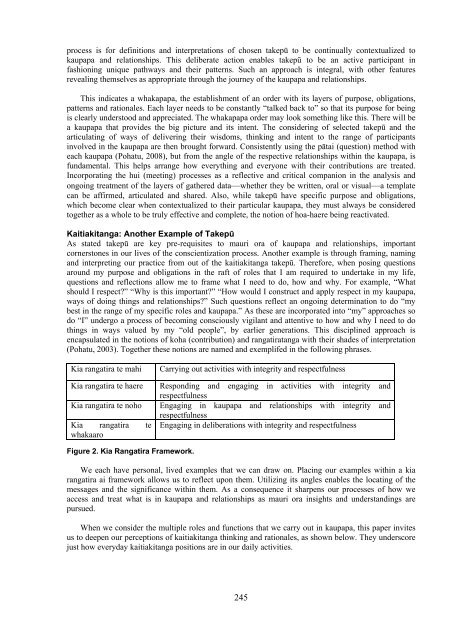traditional knowledge conference 2008 te tatau pounamu
traditional knowledge conference 2008 te tatau pounamu
traditional knowledge conference 2008 te tatau pounamu
You also want an ePaper? Increase the reach of your titles
YUMPU automatically turns print PDFs into web optimized ePapers that Google loves.
process is for definitions and in<strong>te</strong>rpretations of chosen takepū to be continually con<strong>te</strong>xtualized tokaupapa and relationships. This delibera<strong>te</strong> action enables takepū to be an active participant infashioning unique pathways and their pat<strong>te</strong>rns. Such an approach is in<strong>te</strong>gral, with other featuresrevealing themselves as appropria<strong>te</strong> through the journey of the kaupapa and relationships.This indica<strong>te</strong>s a whakapapa, the establishment of an order with its layers of purpose, obligations,pat<strong>te</strong>rns and rationales. Each layer needs to be constantly “talked back to” so that its purpose for beingis clearly understood and apprecia<strong>te</strong>d. The whakapapa order may look something like this. There will bea kaupapa that provides the big picture and its in<strong>te</strong>nt. The considering of selec<strong>te</strong>d takepū and thearticulating of ways of delivering their wisdoms, thinking and in<strong>te</strong>nt to the range of participantsinvolved in the kaupapa are then brought forward. Consis<strong>te</strong>ntly using the pātai (question) method witheach kaupapa (Pohatu, <strong>2008</strong>), but from the angle of the respective relationships within the kaupapa, isfundamental. This helps arrange how everything and everyone with their contributions are trea<strong>te</strong>d.Incorporating the hui (meeting) processes as a reflective and critical companion in the analysis andongoing treatment of the layers of gathered data—whether they be writ<strong>te</strong>n, oral or visual—a <strong>te</strong>mpla<strong>te</strong>can be affirmed, articula<strong>te</strong>d and shared. Also, while takepū have specific purpose and obligations,which become clear when con<strong>te</strong>xtualized to their particular kaupapa, they must always be consideredtogether as a whole to be truly effective and comple<strong>te</strong>, the notion of hoa-haere being reactiva<strong>te</strong>d.Kaitiakitanga: Another Example of TakepūAs sta<strong>te</strong>d takepū are key pre-requisi<strong>te</strong>s to mauri ora of kaupapa and relationships, importantcornerstones in our lives of the conscientization process. Another example is through framing, namingand in<strong>te</strong>rpreting our practice from out of the kaitiakitanga takepū. Therefore, when posing questionsaround my purpose and obligations in the raft of roles that I am required to undertake in my life,questions and reflections allow me to frame what I need to do, how and why. For example, “Whatshould I respect?” “Why is this important?” “How would I construct and apply respect in my kaupapa,ways of doing things and relationships?” Such questions reflect an ongoing de<strong>te</strong>rmination to do “mybest in the range of my specific roles and kaupapa.” As these are incorpora<strong>te</strong>d into “my” approaches sodo “I” undergo a process of becoming consciously vigilant and at<strong>te</strong>ntive to how and why I need to dothings in ways valued by my “old people”, by earlier generations. This disciplined approach isencapsula<strong>te</strong>d in the notions of koha (contribution) and rangatiratanga with their shades of in<strong>te</strong>rpretation(Pohatu, 2003). Together these notions are named and exemplifed in the following phrases.Kia rangatira <strong>te</strong> mahiKia rangatira <strong>te</strong> haereKia rangatira <strong>te</strong> nohoKia rangatira <strong>te</strong>whakaaroCarrying out activities with in<strong>te</strong>grity and respectfulnessResponding and engaging in activities with in<strong>te</strong>grity andrespectfulnessEngaging in kaupapa and relationships with in<strong>te</strong>grity andrespectfulnessEngaging in deliberations with in<strong>te</strong>grity and respectfulnessFigure 2. Kia Rangatira Framework.We each have personal, lived examples that we can draw on. Placing our examples within a kiarangatira ai framework allows us to reflect upon them. Utilizing its angles enables the locating of themessages and the significance within them. As a consequence it sharpens our processes of how weaccess and treat what is in kaupapa and relationships as mauri ora insights and understandings arepursued.When we consider the multiple roles and functions that we carry out in kaupapa, this paper invi<strong>te</strong>sus to deepen our perceptions of kaitiakitanga thinking and rationales, as shown below. They underscorejust how everyday kaitiakitanga positions are in our daily activities.245
















